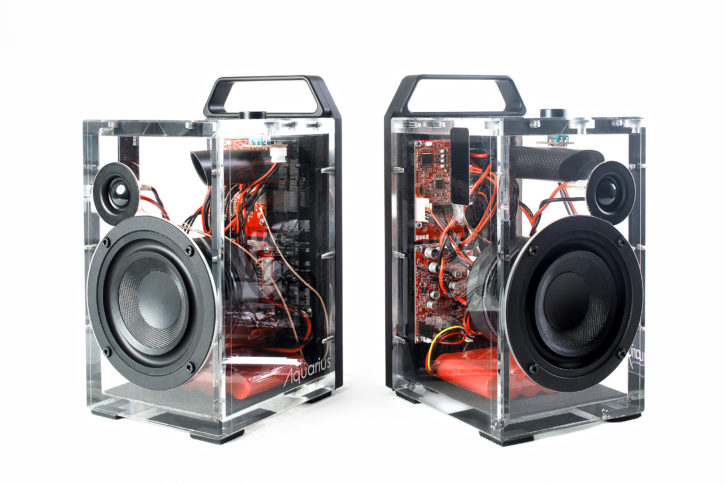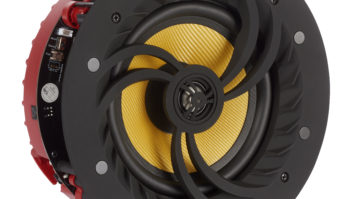
Once taboo due to quality issues, using Wi-Fi for audio has come a long way thanks to high-profile systems such as those from Sonos. Still, though accepted, there are good reasons to avoid it where possible, including compatibility issues, latency concerns, and Wi-Fi bandwidth limitations.
There are times, however, when wireless is the only option, and to combat those concerns, semiconductor manufacturer Eleven Engineering has created the SKAA wireless standard, which either comes as part of the audio equipment (certain speakers from Atlantic Technology, for example) or as a dongle that can added to nearly any audio component.
“Wi-Fi and Bluetooth do a million things, right,” says Rex Whitehead, EVP, sales and marketing for Eleven Engineering. “They do some things spectacularly and they do some things horribly, including audio. We do one thing, and that’s wireless delivery of audio.”
Why SKAA?

“SKAA is the RCA cable of wireless audio,” says Whitehead. “With an RCA cable you could connect a CD player or a VCR or pretty much anything to an AV receiver and it would just work. SKAA does that for wireless audio.”
Eleven Engineering develops wireless audio chips for manufacturers, and had a front-row seat to the compatibility issues facing the industry. “In the early 2000s, we were providing a chip with our solution on it, and we were servicing Bose and Harman and LG…and none of them would work together. There were no compatibility standard whatsoever,” says Whitehead. “As wireless audio started growing up and all of these Wi-Fi- and even Bluetooth-based solutions started appearing, we stepped back and looked at the market and said, ‘Damn — wireless audio needs an RCA cable.’ It needed a standard, something that’s going to work across all of these platforms, regardless of brand, regardless of product. And that’s when the concept of SKAA came around.”
A SKAA dongle can be added to any product if it is not already built-in, which can end compatibility issues and also provides another advantage: “The same SKAA-enabled headphones that I’m using at home for home theater can go on the plane with me or can be used in the back seat of my vehicle for the kids.”
That takes care of compatibility, but what about the bandwidth and latency limitations. SKAA was designed to alleviate both of those issues.
“As far as bandwidth goes, SKAA goes from one transmitter to four receivers, and we call that a cell, and we could have five cells going at one time without having any conflict,” says Whitehead. “We take up about 5 percent of the footprint of what’s available in the 2.4 GHz range. We’ve got this tiny footprint and we’ve got plenty of channels that we can use. We actually created our own frequency hopping so at any point we’re starting with multiple lanes of traffic far in advance, and we’re fast enough to choose the lane without ever bumping heads.”
SKAA’s real-time operating system helps with video latency, according to Whitehead. “We set our video-to-audio latency at 36 milliseconds. The North American standard is 60 milliseconds. But what is really key is that 36-millisecond latency is fixed. With Bluetooth and Wi-Fi, that latency can be variable — it can be fluctuating — so it’s never absolutely locked. SKAA is absolutely locked to all the speakers, and our speaker-to-speaker sync is less than 40 microseconds. We are a wireless solution that’s perfectly suitable for use with video and with gaming.”
SKAA In Use
The true test of a wireless audio system is how it functions in the home theater. “We’re fast enough that you’re not going to have any bad experience due to latency,” says Whitehead. “As mentioned, you can have several ecosystems running concurrently. For a 7.1-channel system, you would need two transmitters either embedded in the AVR or on a dongle inserted into the device.”
Additionally, for a media room, SKAA can offer some flexibility for the homeowner. “Let’s say you had a 3.1 soundbar, and that’s what you listen to all week,” explains Whitehead. “Then Friday night rolls around and you want to really kick it up a notch and you have these SKAA speakers in your game room. You can bring them and temporarily set them up in the back of your media room for movie night, and they would automatically connect. We put profiles in SKAA where that basic 3.1 soundbar would say, ‘Ooh, the rear channels just connected to me. I’m going to reconfigure now. I’m no longer 3.1. I’m a 5.1.’ So the user doesn’t have to change it.”
Related: Wired vs. Wireless Audio
Scratching the Surface
SKAA is a versatile platform that is finding use cases all across the audio spectrum, including headphones, marine installations, and as a beat-accurate tool for DJs. At this time, it cannot handle high-res audio, which may be a dealbreaker for some clients, but for those who need frame-accurate sync and are not looking to be tied to specific brands, SKAA is worth investigating.
For more information, visit https://skaa.com.
Residential Systems is now on LinkedIn! Click here to follow us for business and technology insights!







